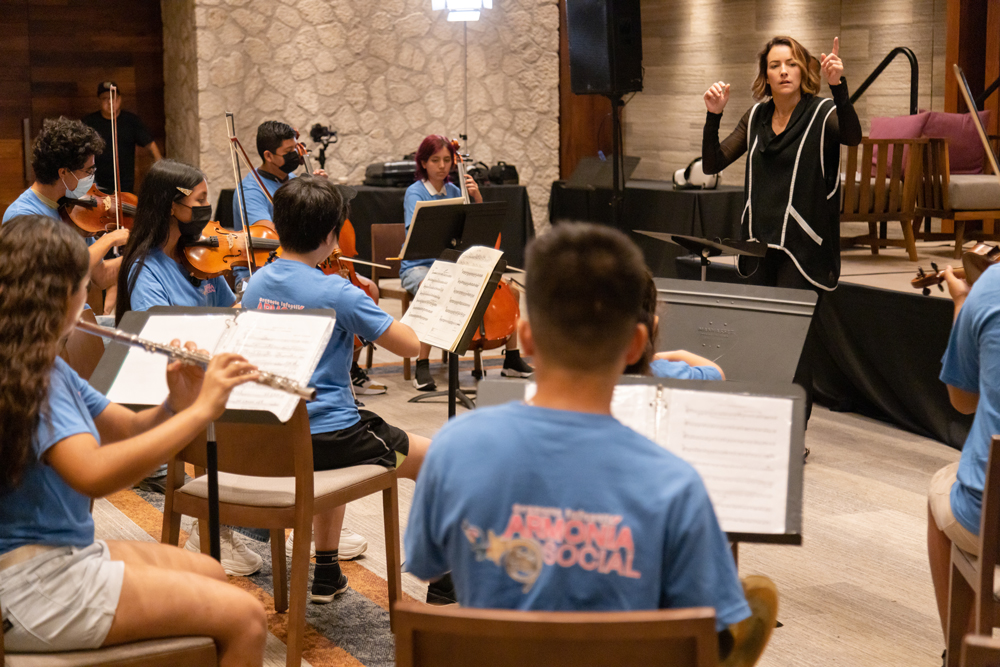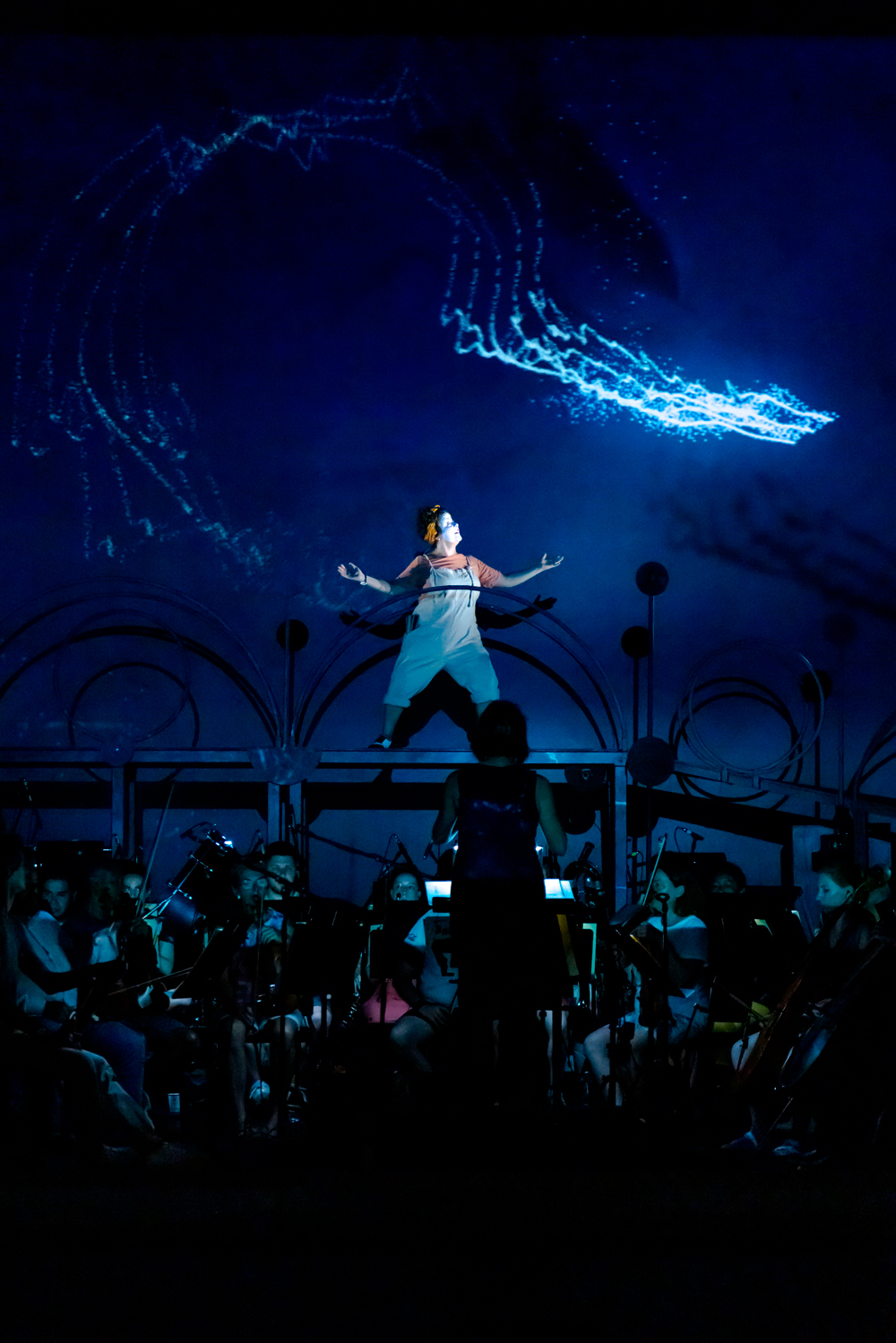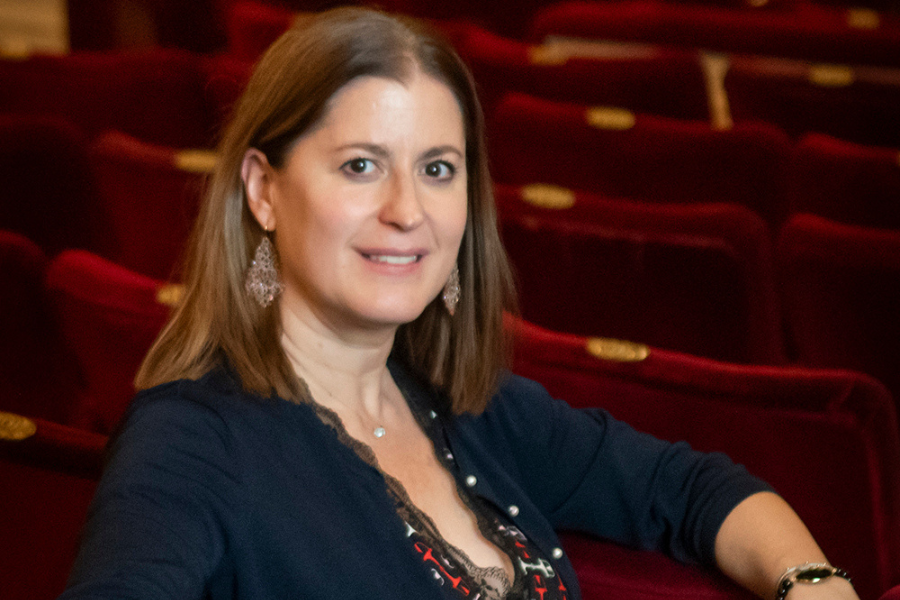Alondra de la Parra: “Debe primar la cooperación por encima de la competitividad”

En un año en que inauguró el primer festival curado por ella misma, dirigió estrenos mundiales de obras musicales y estuvo al frente de algunas de las orquestas más reconocidas de la escena cultural, la directora de orquesta Alondra de la Parra está en uno de los mejores momentos de su carrera. Hoy se encuentra preparando nuevos proyectos, pero sin dejar de lado una visión multidisciplinar y colaborativa: «La coproducción entre teatros, compañías y orquestas juega un papel fundamental en esto porque conlleva una práctica en la que debe primar la cooperación por encima de la competitividad, el trabajo en equipo sobre el individualismo y el entender las artes como una práctica multidisciplinar», explica Alondra en esta entrevista exclusiva para Ópera Latinoamérica.
por M. Angélica Navarro O.
Directora de orquesta, gestora cultura y activista, Alondra de la Parra es una de las artistas latinoamericanas de mayor proyección internacional. “Soy una artista que dirige orquestas, que gestiona proyectos y que entiende que mi trabajo y mi persona pueden tener un impacto positivo en la sociedad. Esto es un gran privilegio que por supuesto entiendo como una responsabilidad, y que tengo en mente en cada paso que doy en mi carrera profesional”, expresa la artista, fundadora de la Orquesta Filarmónica de las Américas y principal directora invitada de la Orchestra Sinfonica di Milano desde 2022.
Con la música de este continente bajo el brazo, de la Parra ha dirigido orquestas como Orchestre de Paris, London Philharmonic Orchestra, Tonhalle-Orchester Zürich, WDR Symphony Orchestra, BBC Philharmonic y L’Orchestra – Accademia Nazionale di Santa Cecilia en conciertos y producciones escénicas. En conciertos que dirige en diferentes ciudades del mundo, pueden convivir obras de Sergei Prokofiev, Arturo Márquez, Dmitri Shostakovich o Gabriela Ortiz. Habitualmente presenta programas con obras de compositores hispanoamericanos en ciudades de América y Europa y dirigió el estreno mundial del ballet Como agua para chocolate, creación de Joby Talbot (música) y Christopher Wheeldon (coreografía) basada en la novela de escritora mexicana Ángeles Mastreta, que debutó en la Royal Opera House de Londres y se presentará en el Metropolitan Opera de Nueva York en junio de 2023.
De origen mexicano, Alondra de la Parra nació en Estados Unidos y creció en México. Comenzó su formación musical a los 7 años con el piano y a los 13 años incursionó en el violonchelo. Continuó sus estudios en composición en el Centro de Investigación y Estudios Musicales (CIEM) de México y luego profundizó en piano y dirección orquesta en Manhattan School of Music de Nueva York. “Recuerdo cuando de niña me dije a mí misma que quería dirigir orquestas, una de las primeras dudas que me asaltó era: ¿Cómo voy a hacer esto si no soy hombre, blanco, adulto y europeo? Porque esa era la figura prototipo del director de orquesta, y yo no cumplía ninguno de esos criterios”, comenta de la Parra. Hace más de dos décadas, la artista oficia como directora de orquesta, con un trabajo que ha sido ampliamente reconocido. Desde el comienzo de su carrera, ha tenido en el centro el impulso de los artistas –creadores e intérpretes– latinoamericanos.

En junio y julio se realizó la primera versión del Festival Paax GNP, un evento de música y artes escénicas impulsado por Alondra de la Parra.
¿Cuál es su mirada respecto de la globalización y la revalorización de las culturas e identidades locales? ¿Qué desafíos y oportunidades se abren en momentos en que nos estamos haciendo preguntas o replanteando la configuración del mundo?
Más que un mundo globalizado, yo pienso que debemos dirigirnos a un mundo donde prime el respeto. Para mí eso es lo más importante, y el mundo sería un lugar muy distinto si las normas de juego se basaran en torno al respeto y la confianza. Bajo esta mirada, todas las culturas e identidades son igual de válidas, no existen supremacías culturales y el planeta es un lugar que cuidar. Da igual donde hayas nacido o el idioma que hables. Es desde esta perspectiva que nos deberíamos replantear la reconfiguración del mundo.
Esto afecta directamente a la cultura, como a todos los ámbitos de nuestra vida. Particularmente en mi trabajo de directora de orquesta lo veo muy claro: Mi rol es el de trabajar conjuntamente con la orquesta para que los músicos puedan hacer su trabajo lo mejor posible, sin jerarquías, sin dictámenes… es una constante conversación entre los músicos y yo. Es al mismo tiempo un desafío y una oportunidad. Desafío porque rompe con el estereotipo tradicional del director de orquesta, que con su batuta ordena, y también oportunidad, porque demuestra que existen otras formas de liderazgo.
«Muchas veces no se tiene en cuenta el papel fundamental que tiene la música para la infancia y la juventud»
2022 fue un año intenso para la directora de orquesta mexicana. En abril fue nombrada principal directora invitada de la Orchestra Sinfonica di Milano y en junio dirigió, en Londres, el estreno mundial del ballet Como agua para chocolate, una co-producción entre el Royal Ballet y el American Ballet. En junio y julio se realizó la primera versión del Festival Paax GNP, un evento de música y artes escénicas realizado en el Caribe mexicano, que reunió a connotados artistas y atractivos estrenos. La iniciativa también impulsó un programa de educación musical orquestal para niños y jóvenes de la región, Armonía Social, con la intención de crear orquestas regionales y formar a los músicos mexicanos del futuro.
También estrenó The Silence of Sound, un proyecto artístico multidisciplinario creado junto a Gabriela Muñoz, conocida artísticamente como Chula The Clown, que ofrece un acercamiento a la música de tradición escrita, en base a un repertorio universal. Hacia fin de año, Alondra de la Parra lanzó su último disco, Olé México, un repertorio que fusiona la música popular y la clásica –con la interpretación de la Orquesta Solistas de América y las voces de Lila Downs, Buika, Pitingo– y que ha tocado en vivo en diferentes ciudades de México.
¿Qué elementos son importantes de considerar para romper con el mito de que la música “clásica” –o de tradición escrita– sólo es para las élites?
Realmente es una de las nubes grises que envuelven a la música clásica: su concepción elitista. Como artista, soy consciente de ello, pero al mismo tiempo pienso que el papel de la música es el de hacernos sentir, el de acompañarnos en la vida, disparar la imaginación, y eso debería ser accesible para todo el mundo.
Además, muchas veces no se tiene en cuenta el papel fundamental que tiene la música para la infancia y la juventud. Entender la música clásica como algo dedicado únicamente a un público adulto es bajo mi punto de vista un error. Especialmente la educación en música, el formar parte de una orquesta, el aprender a tocar un instrumento. Todas estas cosas nos enseñan constancia, trabajo en equipo, nos muestran nuevos lenguajes a través de los cuales expresarnos… Por todo ello la música debería ser una parte fundamental en la educación de todas las personas, y es algo que debe empezar con la educación escolar desde pequeños. Esta es la idea detrás del proyecto Armonía Social que hemos empezado desde el Festival PAAX GNP.
El programa de The Silence of Sound incluye obras de reconocidos compositores del siglo XX, como Debussy, Bartók, Stravinsky o Prokofiev. ¿Por qué decidió elegir esas piezas musicales? ¿Qué elementos tomó en cuenta para crear el programa?
The Silence of Sound es una historia de dualidades, en donde la música y el clown se encuentran y explican la historia de la vida de la protagonista: A través de la música y los gestos vemos como el personaje atraviesa la niñez, la juventud, conoce el amor, la pasión, también el desencuentro, la mala gestión del poder, el arrepentimiento, el perdón. Por supuesto tiene un componente biográfico, pero para mí era importante que el mayor número de personas pudieran sentirse identificadas con la historia. Esto tiene mucho que ver con la pregunta de la relación con los tiempos que corren.
«Entender la música clásica como algo dedicado únicamente a un público adulto es bajo mi punto de vista un error.»
The Silence of Sound cuenta una historia absolutamente actual y de todos los tiempos. Decimos que The Silence of Sound está pensado para personas de 0 a 120 años, y lo pensamos realmente. Siempre es un buen momento de acercar la música clásica a la sociedad, este punto es clave en The Silence of Sound, y tiene mucho que ver con el momento social actual. La selección de las obras que componen el programa construyen una una guía orquestal a través de la cual el oyente va descubriendo grandes piezas del siglo XX, y a su vez las distintas partes de la orquesta.
¿Qué diagnóstico tiene usted respecto de la difusión del repertorio latinoamericano en los teatros y salas de concierto del continente? ¿Cree que es suficiente o se podría hacer más?
Me considero una persona muy exigente, y desde esa perspectiva por supuesto pienso que siempre se puede hacer más. Sin embargo, no podemos olvidar el gran impulso que se ha hecho en los últimos años. Actualmente existen grandes artistas latinoamericanos a los que debemos dar voz. Éste era uno de los objetivos del Festival PAAX GNP y de la Orquesta Filarmónica de las Américas, por ejemplo. Me siento orgullosa de todos mis colegas artistas que trabajan fuerte y constantemente para llevar la música latinoamericana a salas y teatros del mundo.
Una parte importante –prácticamente la mitad– de la programación del Festival Paax la conformaron obras de creadores latinoamericanos. ¿Por qué decidió hacer esa combinación? ¿Cuál fue la recepción de los públicos?
La recepción del público fue excelente. Me llena de emoción recordar aquellos momentos, la felicidad palpable en el ambiente durante los conciertos es algo que no olvidaré nunca. Fue una gran experiencia para mí. Desde muy joven he sentido un gran compromiso con la cultura latinoamericana, y para mí es importante que la música que producimos desde ahí llegue al mundo, y al mismo también acercarla a las personas de Latinoamérica. A cuantas más, mejor: La música es emoción, pasión, disfrute, dolor… la música puede explicarte la vida, y eso es algo que debería estar disponible a todas las personas, independientemente de dónde vivas, la educación o la edad que tengas.
La primera edición del Festival PAAX GNP fue una gran aventura, y un gran salto a lo desconocido. Me siento feliz de haber podido llevarlo a cabo y me llena de orgullo y emoción comunicar que ya estamos preparando la segunda edición para el año 2023.
Sucede muchas veces que la inclusión de repertorio latinoamericano en las temporadas –tal como ocurre con la música contemporánea– genera una suerte de choque cultural entre el público más conservador y aquel que es más abierto a escuchar otras estéticas. Usted tiene experiencia en esta materia: ¿Cuál es la clave para lograr que esa combinación sea exitosa en términos de públicos?
Pienso que no existe una fórmula matemática para garantizar el éxito en estos casos. Por supuesto hay muchos factores que influyen, como la calidad de la pieza, de los músicos que las interpretan, pero también la disposición del público y sus afinidades y experiencias previas. Son los espectadores los que, al recibir las piezas, las completan. Todo esto son elementos variables que nos resulta imposible controlar.
Es muy importante replantearnos lo que entendemos por éxito. En la industria de la música clásica tradicionalmente medimos el éxito basándonos en parámetros como la asistencia y la crítica de expertos. Y por supuesto estos son parámetros que pueden ser válidos, pero es necesario plantearnos la posibilidad de medir el éxito también bajo otros términos: Por ejemplo: ¿Cuántas personas que han asistido al concierto habían escuchado un repertorio latinoamericano en una sala de conciertos? ¿Qué cosas nuevas han descubierto, o sentido, al escuchar estas piezas? ¿Les ha despertado interés en conocer el repertorio musical de estas culturas? Para mí, si alguna de estas preguntas aparece en la mente de los asistentes, sin duda la combinación ha sido exitosa.
Los países hispanoamericanos compartimos un mismo idioma y parte de nuestra historia. ¿Qué oportunidades cree que hay para los nuevos creadores del mundo hispanohablante en esta época, teniendo en cuenta además que los teatros, compañías y orquestas están tendiendo cada vez más a la coproducción de espectáculos?
Es algo magnífico que las puertas de la música sinfónica se abran a otras culturas. La música es un lenguaje que nos narra historias, pone voz a nuestra imaginación y a nuestras vivencias. Cuantas más oportunidades haya para que distintas personas, de diferentes culturas y perspectivas puedan participar en la creación de una narrativa, más rica, completa y amplia será la historia que contemos.
«En la industria de la música clásica tradicionalmente medimos el éxito basándonos en parámetros como la asistencia y la crítica de expertos. Y por supuesto estos son parámetros que pueden ser válidos, pero es necesario plantearnos la posibilidad de medir el éxito también bajo otros términos.»
La coproducción entre teatros, compañías y orquestas juega un papel fundamental en esto, no únicamente por las oportunidades de apertura cultural que genera, sino porque también conlleva una práctica en la que debe primar la cooperación por encima de la competitividad, el trabajo en equipo sobre el individualismo y el entender las artes como una práctica multidisciplinar. Para mí este es el futuro de las artes.
Una de las formas de generar interés o identificación con los espectadores es la proximidad territorial. ¿Puede ser la música de compositores latinoamericanos una forma de acercar a nuevos públicos a las salas de conciertos y teatros que cultivan artes “clásicas”?
Claro. El tema de la identificación, tan en boga en los últimos años, es de plena importancia. Recuerdo cuando de niña me dije a mí misma que quería dirigir orquestas, una de las primeras dudas que me asaltó era ¿Cómo voy a hacer esto si no soy hombre, blanco, adulto y europeo? Porque esa era la figura prototipo del director de orquesta, y yo no cumplía ninguno de esos criterios. Pienso que tener referencias –ya sean de personas, musicales, visuales– con las que nos podamos identificar y sentir representados influye directamente en cómo nos acercamos a las cosas que nos rodean.
¿Qué le diría a sus colegas programadores de otros festivales, salas o teatros para incentivarlos a incluir más repertorio latinoamericano? ¿Qué rol cree que tienen los artistas en este ámbito?
En mi experiencia, tanto por ejemplo con la Orquesta Sinfónica de las Américas o con el último disco que he producido, Olé México, hay una sed para este tipo de repertorio. Tanto para programadores como para artistas es importante salir de nuestra zona de confort. Mi comentario sería “Sean valientes, exploren, déjense llevar por la curiosidad y por el compromiso con hacer buena música”.









